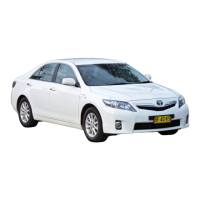Do you have a question about the Toyota CAMRY 2016 and is the answer not in the manual?
Covers safe driving practices and vehicle operation.
Instructions for preparing the vehicle before driving.
Adjusting seat, mirrors, and seat belts for safe driving.
Details on correct use, fastening, and releasing seat belts.
Information on SRS front, side, and curtain shield airbags.
Explains the meaning and function of dashboard warning lights.
Operation of remote control for locks, windows, and trunk.
Procedures for operating vehicle doors.
Instructions for unlocking and locking doors from outside and inside.
Operation of smart key for doors, trunk, and engine start.
Instructions for adjusting front and rear seats.
Procedures for adjusting manual and power front seats.
Procedures for adjusting steering wheel and mirrors.
Adjustment procedure and horn operation.
Covers pre-driving checks and procedures.
Procedures for starting, driving, stopping, and parking the vehicle.
Instructions on starting, stopping, and operating the vehicle.
Shifting the shift lever and understanding shift positions.
Operation and conditions for automatic high beam system.
Operating the wiper lever and washer.
Information on cruise control and driver assistance systems.
Summary of functions and setting the vehicle speed.
Supplements cruise control with distance control.
System recognizes lane markers to alert driver of lane deviation.
Assists driver with guide lines and view behind the vehicle.
Overview of systems like ABS, VSC, TRAC, EPS, PCS, BSM.
Automatically engages brakes to lessen impact during frontal collision.
System assisting lane changes and backing up.
Preparations and driving advice for winter conditions.
Instructions for configuring system settings like language and audio.
Adjusting clock, language, sound, and display settings.
Configuring voice guidance and recognition settings.
Procedures for registering and connecting Bluetooth devices.
Step-by-step guide for connecting Bluetooth devices.
Steps to register an audio player with the system.
Steps to register a phone for hands-free system use.
How to register Bluetooth compatible phones and audio players.
Using the hands-free phone system.
Procedures for dialing numbers and contacts.
Checking and replying to messages via multimedia system.
Troubleshooting common hands-free system issues.
Operation of manual and automatic systems, and defoggers.
Overview of maintenance requirements, general, scheduled, and DIY.
Ensuring safe driving through regular checks and maintenance.
Procedures that owners can perform themselves.
Instructions for performing maintenance tasks yourself.
Safety precautions before performing maintenance.
Checking and adding engine oil.
Checking and adding brake fluid.
Instructions for checking treadwear, rotation, and replacement.
Replacing the battery in the remote control or electronic key.
Procedure for checking and replacing blown fuses.
Procedure for stopping the vehicle in an emergency.
Procedures for dealing with various vehicle problems.
Troubleshooting symptoms and causes of vehicle issues.
List of warning lights, buzzers, and their meanings/actions.
Actions to take when warning messages appear.
Procedure for replacing a flat tire.
Troubleshooting steps when the engine fails to start.
Procedures for locking/unlocking doors and starting the engine.
Procedures for jump-starting a vehicle with a discharged battery.
Correction procedures for engine overheating.
Procedures for freeing a stuck vehicle in mud, dirt, or snow.
Covers safe driving practices and vehicle operation.
Instructions for preparing the vehicle before driving.
Adjusting seat, mirrors, and seat belts for safe driving.
Details on correct use, fastening, and releasing seat belts.
Information on SRS front, side, and curtain shield airbags.
Explains the meaning and function of dashboard warning lights.
Operation of remote control for locks, windows, and trunk.
Procedures for operating vehicle doors.
Instructions for unlocking and locking doors from outside and inside.
Operation of smart key for doors, trunk, and engine start.
Instructions for adjusting front and rear seats.
Procedures for adjusting manual and power front seats.
Procedures for adjusting steering wheel and mirrors.
Adjustment procedure and horn operation.
Covers pre-driving checks and procedures.
Procedures for starting, driving, stopping, and parking the vehicle.
Instructions on starting, stopping, and operating the vehicle.
Shifting the shift lever and understanding shift positions.
Operation and conditions for automatic high beam system.
Operating the wiper lever and washer.
Information on cruise control and driver assistance systems.
Summary of functions and setting the vehicle speed.
Supplements cruise control with distance control.
System recognizes lane markers to alert driver of lane deviation.
Assists driver with guide lines and view behind the vehicle.
Overview of systems like ABS, VSC, TRAC, EPS, PCS, BSM.
Automatically engages brakes to lessen impact during frontal collision.
System assisting lane changes and backing up.
Preparations and driving advice for winter conditions.
Instructions for configuring system settings like language and audio.
Adjusting clock, language, sound, and display settings.
Configuring voice guidance and recognition settings.
Procedures for registering and connecting Bluetooth devices.
Step-by-step guide for connecting Bluetooth devices.
Steps to register an audio player with the system.
Steps to register a phone for hands-free system use.
How to register Bluetooth compatible phones and audio players.
Using the hands-free phone system.
Procedures for dialing numbers and contacts.
Checking and replying to messages via multimedia system.
Troubleshooting common hands-free system issues.
Operation of manual and automatic systems, and defoggers.
Overview of maintenance requirements, general, scheduled, and DIY.
Ensuring safe driving through regular checks and maintenance.
Procedures that owners can perform themselves.
Instructions for performing maintenance tasks yourself.
Safety precautions before performing maintenance.
Checking and adding engine oil.
Checking and adding brake fluid.
Instructions for checking treadwear, rotation, and replacement.
Replacing the battery in the remote control or electronic key.
Procedure for checking and replacing blown fuses.
Procedure for stopping the vehicle in an emergency.
Procedures for dealing with various vehicle problems.
Troubleshooting symptoms and causes of vehicle issues.
List of warning lights, buzzers, and their meanings/actions.
Actions to take when warning messages appear.
Procedure for replacing a flat tire.
Troubleshooting steps when the engine fails to start.
Procedures for locking/unlocking doors and starting the engine.
Procedures for jump-starting a vehicle with a discharged battery.
Correction procedures for engine overheating.
Procedures for freeing a stuck vehicle in mud, dirt, or snow.
| Brand | Toyota |
|---|---|
| Model | CAMRY 2016 |
| Category | Automobile |
| Language | English |











